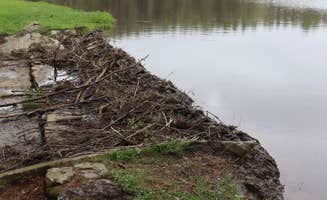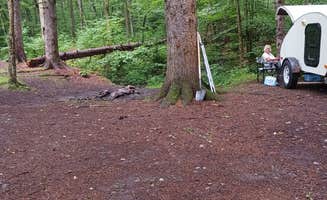Dispersed camping near Portageville, New York provides access to the western Finger Lakes region's hemlock-hardwood forests with elevations ranging from 1,200-2,080 feet. State forest camping in this area features steep terrain with numerous streams and small ponds, creating distinct microclimates. Winter camping requires preparation for temperatures that regularly drop below 20°F, while summer campers should plan for occasional thunderstorms that can develop rapidly across the region.
What to do
Fishing opportunities: At Palmers Pond State Forest, visitors can fish directly from their campsites. One recent camper noted, "The site was very nice. Clean and well maintained. I was able to set up next to the water with no problem." The pond supports several fish species and allows shore fishing without special permits beyond New York state fishing license.
Hiking on Finger Lakes Trail: Several primitive campsites provide direct access to sections of the 580-mile Finger Lakes Trail system. At Boyce State Forest, hikers can access the trail near designated camping areas. A visitor shares, "If you walk/hike 1/2 mile you will find a lean-to with fire pit and privy." Trail conditions vary seasonally, with some sections requiring waterproof footwear.
Wildlife observation: The region supports diverse wildlife populations including white-tailed deer, wild turkey, beaver, and numerous bird species. Early morning provides optimal viewing times at waterfront sites. One camper at Palmers Pond reported, "Lots of beavers to watch throughout the day," making it an excellent location for wildlife photography or observation.
What campers like
Solitude and quiet: Many campers value the remote nature of these sites, particularly during weekdays. One visitor to Camp Seneca reported, "We came into the area on a Monday and this camp was completely empty. We picked the biggest site next to the creek." Most sites maintain substantial distance from neighbors, creating private camping experiences.
Natural shelter: Dense forest canopy at many sites provides natural shelter during rain events. As one camper at Camp Seneca noted, "The tree canopy over our site was dense enough that we did not get very wet when it rains." This natural cover creates comfortable camping conditions during light precipitation.
Accessible waterfront: Campers consistently mention the ease of accessing water at several sites. A Palmers Pond visitor shared, "Beautiful grassy spots around the pond and along the road in." Sites adjacent to water bodies often feature level terrain suitable for tent setup within 10-30 feet of shorelines.
What you should know
Alternative navigation required: GPS directions frequently lead to impassable roads or dead ends. For Palmers Pond, specific approach routes are essential. A camper advises, "When you get off of Interstate 86 you will want to take turnpike rd to south road. There are not any lights to show the sign so it's kinda hard to find."
Variable site conditions: Site maintenance varies considerably between locations. At Ossian State Forest, a recent visitor reported, "Obvious that the area has not been tended to in some time. Only a couple of the primitive sites are accessible and most of the trails are choked with growth or blocked with fallen trees." Checking recent reviews before travel helps identify current conditions.
Limited facilities: Most sites lack developed amenities. Where available, pit toilets receive minimal maintenance. One Camp Seneca visitor noted, "There was a porti-poty on site that had plenty of paper was pretty clean." Campers should bring toilet paper, hand sanitizer, and all water needs.
Tips for camping with families
Weather preparation: Temperature fluctuations require appropriate clothing layers. At Boyce State Forest, conditions can change rapidly with one camper noting, "Trail was more of a stream than a trail. You'll spend more time beside the trail than actually on it." Pack extra footwear and rain gear for children, even during forecasted clear weather.
Site selection strategy: Families benefit from selecting sites with natural boundaries and level ground. The grassy areas at Palmers Pond State Forest provide ideal setup locations, with a visitor describing "Abundant flat and grassy terrain under pines near a beautiful lake." Sites nearest access roads typically offer the flattest terrain.
Activity planning: Limited on-site amenities require advance activity planning. Pack nature identification guides, fishing equipment, and portable games. Morning wildlife observation followed by afternoon fishing creates structured activities at water-adjacent sites.
Tips from RVers
Road condition assessment: Forest access roads require careful navigation for RVs. Several campers recommend scouting roads before bringing in larger rigs. One visitor to Palmers Pond shared, "The written directions from other reviews were easy to follow. The road was gravel but pretty easy to drive."
Seasonal timing considerations: Spring access presents challenges for RVs. A Boyce State Forest camper recommended visits during "dryer season" as wet conditions significantly impact road navigability. Most RV-accessible sites close after significant snowfall, typically mid-November through April.
Site leveling requirements: RV camping requires additional leveling equipment. Most forest sites lack prepared pads, though some at Palmer's Pond feature relatively level parking areas. Smaller trailers and truck campers navigate these areas more successfully than larger motorhomes.



